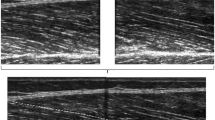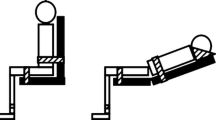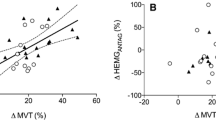Abstract
Purpose
This study examined the relative influence of anatomical and neuromuscular variables on maximal isometric and concentric knee extensor torque and provided a comparative dataset for healthy young males.
Methods
Quadriceps cross-sectional area (CSA) and fascicle length (l f) and angle (θ f) from the four quadriceps components; agonist (EMG:M) and antagonist muscle activity, and percent voluntary activation (%VA); patellar tendon moment arm distance (MA) and maximal voluntary isometric and concentric (60° s−1) torques, were measured in 56 men. Linear regression models predicting maximum torque were ranked using Akaike’s Information Criterion (AICc), and Pearson’s correlation coefficients assessed relationships between variables.
Results
The best-fit models explained up to 72 % of the variance in maximal voluntary knee extension torque. The combination of ‘CSA + θ f + EMG:M + %VA’ best predicted maximum isometric torque (R 2 = 72 %, AICc weight = 0.38) and ‘CSA + θ f + MA’ (R 2 = 65 %, AICc weight = 0.21) best predicted maximum concentric torque.
Conclusion
Proximal quadriceps CSA was included in all models rather than the traditionally used mid-muscle CSA. Fascicle angle appeared consistently in all models despite its weak correlation with maximum torque in isolation, emphasising the importance of examining interactions among variables. While muscle activity was important for torque prediction in both contraction modes, MA only strongly influenced maximal concentric torque. These models identify the main sources of inter-individual differences strongly influencing maximal knee extension torque production in healthy men. The comparative dataset allows the identification of potential variables to target (i.e. weaknesses) in individuals.





Similar content being viewed by others
Abbreviations
- AIC:
-
Akaike’s information criterion (an information-theoretic approach for model selection)
- AICc :
-
Akaike’s information criterion for a small dataset
- ΔAICc :
-
The model's AICc minus the minimum AICc among candidate models
- AICc w i :
-
The percentage of times that a given model would be selected as the ‘best-fit model’ by AICc, and serves as the weight of evidence for a given model being the best model from a set of candidate models
- BF:
-
Biceps femoris
- CI:
-
Confidence interval
- CSA:
-
Anatomical cross-sectional area
- CV:
-
Coefficients of variation
- DIST:
-
Distal region muscle measurements
- EMG:
-
Electromyogram
- EMG:M:
-
Quadriceps EMG amplitude normalised to M-wave amplitude
- EMG:MRF :
-
RF EMG amplitude normalised to RF M-wave amplitude
- EMG:MVL :
-
VL EMG amplitude normalised to VL M-wave amplitude
- EMG:MVM :
-
VM EMG amplitude normalised to VM M-wave amplitude
- EMG:MAVEQ :
-
Average EMG:M ratio of RF, VL and VM
- ICR:
-
Instantaneous centre of rotation
- ICC:
-
Intra-class correlation coefficient
- l f :
-
Fascicle length
- MA:
-
Patellar tendon moment arm distance
- Mmax :
-
Maximum peak-to-peak amplitude of the M-wave
- MVC:
-
Maximal voluntary contraction
- MID:
-
Middle region muscle measurements
- M-wave:
-
Maximum muscle compound action potential of vastus lateralis
- PCSA:
-
Physiological cross-sectional area
- PROX:
-
Proximal region muscle measurements
- RF:
-
Rectus femoris
- RMS:
-
Root mean square
- ROM:
-
Range of motion
- T CON :
-
Maximum voluntary concentric torque
- T CON-QUAD :
-
Maximum quadriceps-only concentric torque
- T ISO :
-
Maximum voluntary isometric torque
- T ISO-QUAD :
-
Maximum quadriceps-only isometric torque
- T Pot-TW :
-
Maximum potentiated twitch torque
- T Un-TW :
-
Maximum unpotentiated twitch torque
- %VA:
-
Percent voluntary activation (calculated by interpolated twitch technique)
- VI:
-
Vastus intermedius
- VL:
-
Vastus lateralis
- VM:
-
Vastus medialis
- θ f :
-
Fascicle angle
References
Aagaard P, Simonsen EB, Andersen JL, Magnusson SP, Bosjen-Moller F, Dyhre-Poulsen P (2000) Antagonist muscle coactivation during isokinetic knee extension. Scand J Med Sci Sports 10:58–67
Aagaard P et al (2001) A mechanism for increased contractile strength of human pennate muscle in response to strength training: changes in muscle architecture. J Physiol 534:613–623
Aagaard P, Simonsen EB, Andersen JL, Magnusson SP, Dyhre-Poulsen P (2002a) Neural adaptation to resistance training: changes in evoked V-wave and H-reflex responses. J Appl Physiol 92:2309–2318
Aagaard P, Simonson EB, Andersen JL, Magnusson P, Dyhre-Poulsen P (2002b) Increased rate of force development and neural drive of human skeletal muscle following resistance training. J Appl Physiol 93:1318–1326
Abe T, Kumagai K, Brechue WF (2000) Fascicle length of leg muscles is greater in sprinters than distance runners. Med Sci Sports Exerc 32:1125–1129
Abe T, Kearns CF, Sato Y (2006) Muscle size and strength are increased following walk training with restricted venous blood flow from the leg muscle, Kaatsu-walk training. J Appl Physiol 100:1460–1466
Ahtiainen JP, Pakarinen A, Alen M, Kraemer WJ, Hakkinen K (2003) Muscle hypertrophy, hormonal adaptations and strength development during strength training in strength-trained and untrained men. Eur J Appl Physiol 89:555–563
Ainsworth BE et al (2000) Compendium of physical activities: an update of activity codes and MET intensities. Med Sci Sports Exerc 32:S498–S516
Amiridis LG, Martin A, Morlon B, Martin L, Cometti G, Pousson M, van Hoecke J (1996) Co-activation and tension-regulating phenomena during isokinetic knee extension in sedentary and highly skilled humans. Eur J Appl Physiol 73:149–156
Arabadzhiev TI, Dimitrov VG, Dimitrova NA, Dimitrov GV (2010) Interpretation of EMG integral or RMS and estimates of “neuromuscular efficiency” can be misleading in fatiguing contraction. J Electromyogr Kinesiol 20:223–232
Arampatzis A, Karamanidis K, Morey-Klapsing G, DeMonte G, Stafilidis S (2007) Mechanical properties of the triceps surae tendon and aponeurosis in relation to intensity of sport activity. J Biomech 40:1946–1952
Arnold TW (2010) Uninformative parameters and model selection using Akaike’s Information Criterion. J Wildl Manage 74:1175–1178
Azizi E, Brainerd EL (2007) Architectural gear ratio and muscle fiber strain homogeneity in segmented musculature. J Exp Zool 307A:145–155
Babault N, Pousson M, Michaut A, Van Hoecke J (2003) Effect of quadriceps femoris muscle length on neural activation during isometric and concentric contractions. J Appl Physiol 94:983–990
Becker R, Awiszus F (2001) Physiological alterations of maximal voluntary quadriceps activation by changes of knee joint angle. Muscle Nerve 24:667–672
Behm DG, St. Pierre MM, Perez D (1996) Muscle inactivation: assessment of interpolated twitch technique. J Appl Physiol 81:2267–2273
Berg HE, Tedner B, Tesch PA (1993) Changes in lower limb muscle cross-sectional area and tissue fluid volume after transition from standing to supine. Acta Physiol Scand 148:379–385
Blazevich AJ, Sharpe NCC (2005) Understanding muscle architectural adaptation: macro- and micro- level research. Cells Tissues Organs 181:1–10
Blazevich AJ, Gill ND, Zhou S (2006) Intra- and intermuscular variation in human quadriceps femoris architecture assessed in vivo. J Anat 209:289–310
Blazevich AJ, Cannavan D, Coleman DR, Horne S (2007) Influence of concentric and eccentric resistance training on architectural adaptation in human quadriceps muscles. J Appl Physiol 103:1565–1575
Blazevich AJ, Coleman DR, Horne S, Cannavan D (2009) Anatomical predictors of maximal isometric and concentric knee extensor moment. Eur J Appl Physiol 105:869–878
Bloomquist K, Langberg H, Karlsen S, Madsgaard S, Boesen M, Raastad T (2013) Effect of range of motion in heavy load squatting on muscle and tendon adaptations. Eur J Appl Physiol 113:2133–2142
Brainerd EL, Azizi E (2005) Muscle fibre angle, segment bulging and architectural gear ratio in segmented musculature. J Exp Biol 208:3249–3261
Burkholder TJ, Fingado B, Baron S, Lieber RL (1994) Relationship between muscle fiber types and sizes and muscle architectural properties in the mouse hindlimb. J Morphol 221:177–190
Burnham KP, Anderson DR (2002) Model selection and multimodel inference: a practical information-theoretic approach, 2nd edn. Springer, New York
Comfort P, Haigh A, Matthews MJ (2012) Are changes in maximal squat strength during preseason training reflected in changes in sprint performance in rugby league players. J Strength Cond Res 26:772–776
Desbrossess K, Babault N, Scaglioni G, Meyer J-P (2006) Neural activation after maximal isometric contractions at different muscle lengths. Med Sci Sports Exerc 38:937–944
Drawer S, Fuller CW (2001) Propensity for osteoarthritis and lower limb joint pain in retired professional soccer players. Br J Sports Med 35:402–408
Farina D, Merletti R, Enoka RM (2004) The extraction of neural strategies from the surface EMG. J Appl Physiol 96:1486–1495
Fath F, Blazevich AJ, Waugh CM, Miller SC, Korff T (2010) Direct comparison of in vivo Achilles tendon moment arms obtained from ultrasound and MR scans. J Appl Physiol 109:1644–1652
Fiorentino NM, Lin JS, Ridder KB, Guttman MA, McVeigh ER, Blemker SS (2013) Rectus femoris knee muscle moment arms measured in vivo during dynamic motion with real-time magnetic resonance imaging. J Biomech Eng 135:044501–044505
Fukunaga T, Miyatani M, Tachi M, Kouzaki M, Kawakami Y, Kanehisa H (2001) Muscle volume is a major determinant of joint torque in humans. Acta Physiol Scand 172:249–255
Gruber M, Gollhofer A (2004) Impact of sensorimotor training on the rate of force development and neural activation. Eur J Appl Physiol 92:98–105
Gur H, Cakin N (2003) Muscle mass, isokinetic torque, and functional capacity in women with osteoarthritis of the knee. Arch Phys Med Rehab 84:1534–1541
Hakkinen K, Keskinen KL (1989) Muscle cross-sectional area and voluntary force production characteristics in elite strength- and endurance-trained athletes and sprinters. Eur J Appl Physiol 59:215–220
Hakkinen K, Komi PV, Alen M (1985) Effect of explosive type strength training on isometric force and relaxation-time, electromyographic and muscle fibre characteristics of leg extensor muscles. Acta Physiol Scand 125:587–600
Hakkinen K et al (1998) Changes in muscle morphology, electromyographic activity, and force production characteristics during progressive strength training in young and older men. J Gerontol 53A:B415–B423
Hermans HJ, Freriks B, Disselhorst-Klug C, Rau G (2000) Development of recommendations for SEMG sensors and sensor placement procedures. J Electromyogr Kinesiol 10:361–374
Hill AV (1938) The heat of shortening and the dynamic constants of muscle. Proc R Soc Lond B Biol Sci 126:136–195
Hodgson M, Docherty D, Robbins D (2005) Post-activation potentiation: underlying physiology and implications for motor performance. Sports Med 35:585–595
Ikegawa S, Funato K, Tsunoda N, Kanehisa H, Fukunaga T, Kawakami Y (2008) Muscle force per cross-sectional area is inversely related with pennation angle in strength trained athletes. J Strength Cond Res 22:128–131
Kawakami Y, Abe T, Fukunaga T (1993) Muscle-fibre pennation angles are greater in hypertrophied than in normal muscles. J Appl Physiol 74:2740–2744
Kellis E, Baltzopoulos V (1997) The effects of antagonist moment on the resultant knee joint moment during isokinetic testing of the knee extensors. Eur J Appl Physiol 76:253–259
Kellis E, Katis A (2008) Hamstring antagonist moment estimation using clinically applicable models: muscle dependeny and synergy effects. J Electromyogr Kinesiol 18:144–153
Kubo K, Tsunoda N, Kanehisa H, Fukunaga T (2004) Activation of agonist and antagonist muscles at different joint angles during maximal isometric efforts. Eur J Appl Physiol 91:349–352
Kumagai K, Takashi A, Brechue WF, Ryushi T, Takano S, Mizuno M (2000) Sprint performance is related to muscle fascicle length in male 100-m sprinters. J Appl Physiol 88:811–816
Lepers R, Millet GY, Maffiuletti NA (2001) Effect of cycling cadence on contractile and neural properties of knee extensors. Med Sci Sports Exerc 33:1882–1888
Lexell J, Henriksson-Larsen K, Sjostrom M (1983) Distribution of different fibre types in human skeletal muscles. 2. A study of cross-sections of whole m. vastus lateralis. Acta Physiol Scand 117:115–122
Lieber RL, Friden J (2000) Functional and clinical significance of skeletal muscle architecture. Muscle Nerve 23:1647–1666
Lord SR, Clark RD, Webster IW (1991) Physiological factors associated with falls in an elderly population. J Am Geriatr Soc 39:1194–2000
Maffiuletti NA, Lepers R (2003) Quadriceps femoris torque and EMG activity in seated versus supine position. Med Sci Sports Exerc 35:1511–1516
Maganaris CN, Baltzopoulos V, Sargeant AJ (1999) Changes in the tibialis anterior tendon moment arm from rest to maximum isometric dorsiflexion: in vivo observations in man. Clin Biomech 14:661–666
Magnaris CN, Baltzopoulos V, Sargeant AJ (1998) Changes in Achilles tendon moment arm from rest to maximum isometric plantarflexion: in vivo observations in man. J Physiol 510:977–985
Maughan RJ, Watson JS, Weir J (1983) Strength and cross-sectional area of human skeletal muscle. J Physiol 338:37–49
Mazerolle MJ (2012) AICcmodavg: model selection and multimodel inference based on (Q)AIC(c) R package version 1.26. http://CRAN.R-project.org/package=AICcmodavg. Accessed 10 June 2013
Miller JP, Croce RV, Hutchins R (2000) Reciprocal coactivation patterns of the medial and lateral quadriceps and hamstrings during slow, medium and high speed isokinetic movements. J Electromyogr Kinesiol 10:233–239
Millet GY, Lepers R (2004) Alterations of neuromuscular function after prolonged running, cycling and skiing exercises. Sports Med 34:105–116
Millet GY, Martin V, Lattier G, Ballay Y (2003) Mechanisms contributing to knee extensor strength loss after prolonged running exercise. J Appl Physiol 94:193–198
Moritani T, de Vries HA (1979) Neural factors versus hypertrophy in the time course of muscle strength gain. Am J Phys Med 58:115–130
Narici MV, Roi GS, Minetti AE, Cerretelli P (1989) Changes in force, cross-sectional area and neural activation during strength training and detraining of the human quadriceps. Eur J Appl Physiol 59:310–319
Narici MV et al (1996) Human quadriceps cross-sectional area, torque and neural activation during 6 months strength training. Acta Physiol Scand 157:175–186
Newman AB et al (2006) Strength, but not muscle mass, is associated with mortality in the health, aging and body composition study cohort. J Gerontol Med Sci 61A:72–77
Noorkoiv M, Nosaka K, Blazevich AJ (2010a) Assessment of quadriceps muscle cross-sectional area by ultrasound extended-field-of-view imaging. Eur J Appl Physiol 109:631–639
Noorkoiv M, Stavnsbo A, Aagaard P, Blazevich AJ (2010b) In vivo assessment of muscle fascicle length by extended field-of-view ultrasonography. J Appl Physiol 109:1974–1979
Noorkoiv M, Nosaka K, Blazevich AJ (2014) Neuromusular adaptations associated with joint angle-specific force change. Med Sci Sports Exerc 46:1525–1537
Osternig LR, Hamill J, Lander J (1986) Co-activation of sprinter and distance runner muscles in isokinetic exercises. Med Sci Sports Exerc 18:431–435
Otten E (1988) Concepts and models of functional architecture in skeletal muscle. Exerc Sport Sci Rev 16:89–173
Petrella RJ, Lattanzio PJ, Nelson MG (1997) Effect of age and activity on knee joint proprioception Am J Phys Med Rehab 73:235–241
Piazza S (2008) Built for speed: musculoskeletal structure and sprinting ability in humans. In: Department of Mechnical and Aerospace Engineering seminar, University of Virginia, Charlottesville
Place N, Maffiuletti NA, Ballay Y, Lepers R (2005) Twitch potentiation is greater after a fatiguing submaximal isometric contraction performed at short vs long quadriceps muscle length. J Appl Physiol 98:429–436
Pratt CA, Chanaud CM, Loeb GE (1991) Functionally complex muscles of the cat hindlimb. IV. Intramuscular distribution of movement command signals and cutaneous reflexes in broad, bifunctional thigh muscles. Exp Brain Res 85:281–299
Ranganathan VK, Siemionow V, Liu JZ, Sahgal V, Yue GH (2004) From mental power to muscle power—gaining strength by using the mind. Neuropsychologia 42:944–956
Rantanen T (2003) Muscle strength, disability and mortality. Scand J Med Sci Sports 13:3–8
Rubenstein LZ, Josephson KR, Trueblood PR, Loy S, Harker JO, Pietruszka FM, Robbins AS (2000) Effects of a group exercise program on strength, mobility, and falls among fall-prone elderly men J Gerontol. Med Sci 55A:M317–M321
Sacks RD, Roy RR (1982) Architecture of the hind limb muscles of cats: functional significance. J Morphol 173:185–195
Seynnes OR, de Boer M, Narici MV (2007) Early skeletal muscle hypertrophy and architectural changes in response to high-intensity resistance training. J Appl Physiol 102:368–373
Sharma L (2003) Examination of exercise effects on knee osteoarthritis outcomes: why should the local mechanical environment be considered? Arthritis Rheum 49:255–260
Simoneau EM, Longo S, Seynnes OR, Narici MV (2011) Human muscle fascicle behavior in agonist and antagonist isometric contractions. Muscle Nerve 45:92–99
Suetta C et al (2007) Muscle size, neuromuscular activation, and rapid force characteristics in elderly men and women: effects of unilateral long-term disuse due to hip-osteoarthritis. J Appl Physiol 102:942–948
Taylor JL (2009) Point: counterpoint: the interpolated twitch does/does not provide a valid measure of voluntary activation of muscle. J Appl Physiol 107:354–355
ter Haar Romney BM, van der Gon JJD, Gielen CCAM (1982) Changes in recruitment order of motor units in the human biceps muscle. Exp Neurol 78:360–368
ter Haar Romney BM, van der Gon JJD, Gielen CCAM (1984) Relation between location of a motor unit in the human biceps brachii and its critical firing levels for different tasks. Exp Neurol 85:631–650
Thom JM, Morse CI, Birch KM, Narici MV (2007) Influence of muscle architecture on the torque and power-velocity characteristics of young and elderly men. Eur J Appl Physiol 100:613–619
Thorstensson A, Karlsson J, Viitasalo HT, Luhtanen P, Komi PV (1976) Effect of strength training on EMG of human skeletal muscle. Acta Physiol Scand 98:232–236
Tsaopoulos DE, Baltzopoulos V, Maganaris CN (2006) Human patellar tendon moment arm length: measurement considerations and clinical implications for joint loading assessment. Clin Biomech 21:657–667
Tsaopoulos DE, Baltzopoulos V, Richards PJ, Magnaris CN (2009) A comparison of different two-dimensional approaches for the determination of the patellar tendon moment arm length. Eur J Appl Physiol 105:809–814
Wagenmakers E-J, Farrell S (2004) AIC models selection using Akaike weights. Psychon B Rev 11:192–196
Watanabe K, Kouzaki M, Moritani T (2012) Task-dependent spatial distribution of neural activation pattern in human rectus femoris muscle. J Electromyogr Kinesiol 22:251–258
Waugh CM, Blazevich AJ, Fath F, Korff T (2012) Age-related changes in mechanical properties of the Achilles tendon. J Anat 220:144–155
Wernbom M, Jarrebring R, Andreasson MA, Augustsson J (2009) Acute effects of blood flow restriction on muscle activity and endurance during fatiguing dynamic knee extensions at low load. J Strength Cond Res 23:2389–2395
Whittingham MJ, Stephens PA, Bradbury RB, Freckelton RP (2006) Why do we still use stepwise modelling in ecology and behaviour? J Anim Ecol 75:1182–1189
Acknowledgments
Funding was provided through the Edith Cowan University post-graduate research scholarship system.
Author information
Authors and Affiliations
Corresponding author
Ethics declarations
Conflict of interest
The authors declare they have no conflict of interest.
Additional information
Communicated by William J. Kraemer.
Rights and permissions
About this article
Cite this article
Trezise, J., Collier, N. & Blazevich, A.J. Anatomical and neuromuscular variables strongly predict maximum knee extension torque in healthy men. Eur J Appl Physiol 116, 1159–1177 (2016). https://doi.org/10.1007/s00421-016-3352-8
Received:
Accepted:
Published:
Issue Date:
DOI: https://doi.org/10.1007/s00421-016-3352-8




